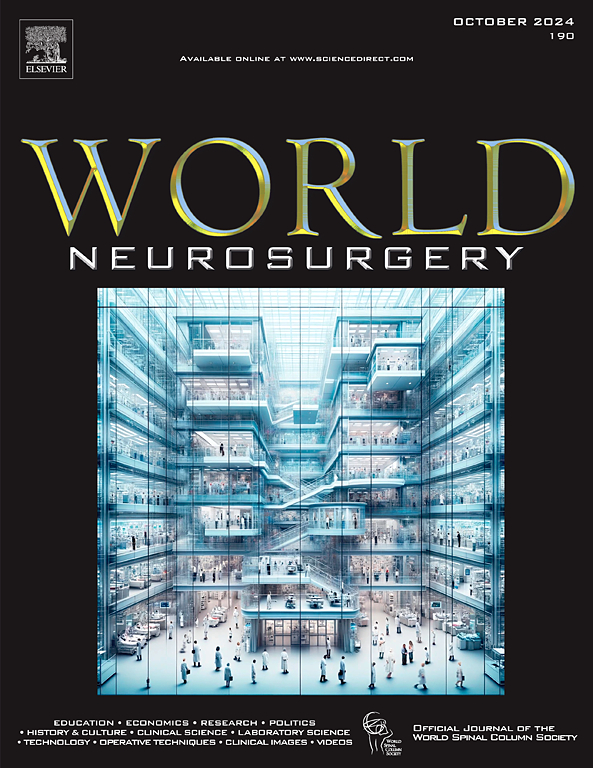Cephalgia Following Flow Diversion of Unruptured Intracranial Aneurysms
IF 1.9
4区 医学
Q3 CLINICAL NEUROLOGY
引用次数: 0
Abstract
Background
Headaches following treatment of unruptured intracranial aneurysms with flow diverting stents is a known, however under-reported, entity. Prevalence of this phenomenon, its clinical and procedural correlates, as well as its clinical course and correlation to aneurysm location and size have not been reported in the past. This manuscript aims to quantify the prevalence of the phenomenon, describe its natural course, and identify risk factors for its emergence.
Methods
Within our prospectively collected institutional database, we identified 141 consecutive patients treated electively for unruptured intracranial aneurysms by flow diversion between 2015 and 2021 who had a minimum of 2 years of clinical follow-up. The mean patient age was 55.7 (±13) y/o and 120/141 patients (85%) were females. Based on chart review and clinical notes we evaluated the presence of postprocedural headache complaints and correlated these with anatomical and periprocedural data. Additionally we have assessed charts of 88 patient who underwent aneurysm coiling without flow diversion during the same time period.
Results
Twenty-four (17%) patients complained of new headaches postflow diversion which were hemicranial or holocranial (n = 17) or retro-orbital (n = 7) in nature. Headaches were most common in paraclinoid, paraophthalmic, and cavernous aneurysms, while retro-orbital pain was correlated to larger aneurysms of same locations mean dimensions and older age (Pearson's correlation, 13 mm ± 5.4, P = 0.04; 65 ± 14, P = 0.048). Two stent constructs were also correlated to retro-orbital headaches (hazard ratio [HR] 3.8, P = 0.03, confidence interval [CI] 1.0–16.4). In addition, in 15 of 24 cases (62.5%) of headache presentations, the stent construct was crossing the dura. In 6 of 7 (87.5%) of patients presenting with retro-orbital headaches the stent construct was crossing the dural ring. The clinical course of the pain syndrome was invariably benign and short-lived (<1 year long). During the same time period only 3 patients (3.4%) in the elective coiling without flow diverter group presented with various duration of holocranial eventually resolving headaches.
Conclusions
In our cohort, new postprocedural headaches following flow-diversion were present in 17% of patients thus constituting a common adverse event that was exclusively related to anterior circulation aneurysms, in contrast to only 3.4% prevalence of new postprocedural headaches following elective aneurysm coiling. The phenomenon was short-lived and benign, related to larger aneurysm size, proximity to the dural ring in the treated segment, double stent construct, and older age. We hypothesize that these headaches may be related to meningeal irritation. We recommend that patients are educated during the consent process of this phenomenon and its clinical course prior to treatment.
未破裂颅内动脉瘤分流后的头痛。
导言:使用分流支架治疗未破裂颅内动脉瘤后的头痛是已知的,但报道不足。这种现象的普遍性、其临床和手术相关性、其临床病程以及与动脉瘤位置和大小的相关性在过去未见报道。本文旨在量化这种现象的普遍性,描述其自然过程,并确定其出现的风险因素。方法:在我们前瞻性收集的机构数据库中,我们确定了141例在2015年至2021年期间通过分流选择性治疗未破裂颅内动脉瘤的连续患者,这些患者至少有2年的临床随访。患者平均年龄为55.7(±13)岁,120/141例(85%)为女性。基于图表回顾和临床记录,我们评估了术后头痛主诉的存在,并将其与解剖学和术中数据相关联。此外,我们还评估了88例在同一时间段内接受动脉瘤盘绕术而没有分流的患者的图表。结果:24例(17%)患者在血流分流后出现新的头痛,其中17例为半颅或全颅性头痛,7例为眶后性头痛。头痛最常见于眼旁动脉瘤(7)、眼旁动脉瘤(4)和海绵状动脉瘤(2),而眶后疼痛与相同位置、平均尺寸和年龄较大的动脉瘤相关(Pearson’s correlation, 13 mm±5.4,p=0.04;65±14,p=0.048)。两种支架结构也与眶后头痛相关(HR 3.8, p=0.03, CI 1.0 -16.4)。此外,在15/24的头痛病例(62.5%)中,支架结构穿过硬脑膜。在6/7(87.5%)出现眶后头痛的患者中,支架结构穿过硬脑膜环。疼痛综合征的临床过程总是良性的和短暂的(讨论和结论:在我们的队列中,17%的患者在血流转移后出现新的手术后头痛,因此构成了一个共同的不良事件,仅与前循环动脉瘤相关,相比之下,选择性动脉瘤缠绕后新的手术后头痛的发生率仅为3.4%。这种现象是短暂的和良性的,与较大的动脉瘤大小,靠近治疗段的硬脑膜环,双支架结构和年龄较大有关。我们假设这些头痛可能与脑膜刺激有关。我们建议患者在同意过程中对这种现象及其治疗前的临床过程进行教育。
本文章由计算机程序翻译,如有差异,请以英文原文为准。
求助全文
约1分钟内获得全文
求助全文
来源期刊

World neurosurgery
CLINICAL NEUROLOGY-SURGERY
CiteScore
3.90
自引率
15.00%
发文量
1765
审稿时长
47 days
期刊介绍:
World Neurosurgery has an open access mirror journal World Neurosurgery: X, sharing the same aims and scope, editorial team, submission system and rigorous peer review.
The journal''s mission is to:
-To provide a first-class international forum and a 2-way conduit for dialogue that is relevant to neurosurgeons and providers who care for neurosurgery patients. The categories of the exchanged information include clinical and basic science, as well as global information that provide social, political, educational, economic, cultural or societal insights and knowledge that are of significance and relevance to worldwide neurosurgery patient care.
-To act as a primary intellectual catalyst for the stimulation of creativity, the creation of new knowledge, and the enhancement of quality neurosurgical care worldwide.
-To provide a forum for communication that enriches the lives of all neurosurgeons and their colleagues; and, in so doing, enriches the lives of their patients.
Topics to be addressed in World Neurosurgery include: EDUCATION, ECONOMICS, RESEARCH, POLITICS, HISTORY, CULTURE, CLINICAL SCIENCE, LABORATORY SCIENCE, TECHNOLOGY, OPERATIVE TECHNIQUES, CLINICAL IMAGES, VIDEOS
 求助内容:
求助内容: 应助结果提醒方式:
应助结果提醒方式:


